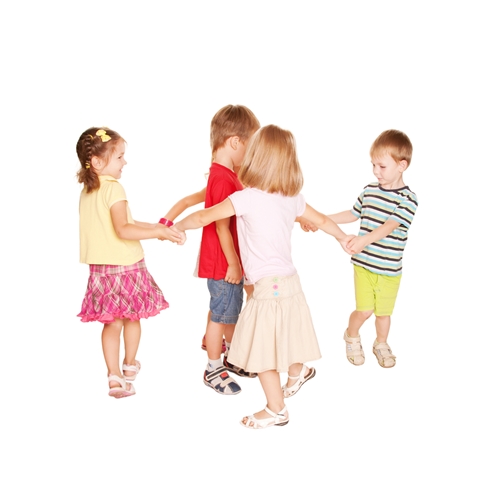As any dance teacher who’s worked with young children knows, kids have a boundless supply of energy. Attempts to teach them technique or choreography often end in vain, with aggravated children and an even more frustrated teacher. Young preschool- and kindergarten-age children generally don’t have the attention span or discipline to do barre work or learn correct technique, but this young and energetic age group is perfectly suited to succeed at creative movement. You can take advantage of their energy with creative movement lesson plans.
Creative movement is offered as a class at many dance studios and is designed to introduce children to the idea of expressing themselves through movement. The creative movement lesson plans work with young children’s natural enthusiasm, short attention spans and high energy levels to explore basic concepts of dance and creativity.
There are many benefits of creative movement. According to the National Association for the Education of Young Children, creative movement aids children’s physical development, teaching them body awareness and control and how to move around in a space. It also encourages them to use their imaginations and become comfortable with expressing themselves.
It helps them grow socially and emotionally, since they must learn to share space with others, and expressing themselves in a myriad of ways – for example, pretending to be a certain animal or acting like a type of weather – helps them recognize that they have a wide range of feelings. Additionally, creative movement classes teach children to be respectful in a class-setting and effectively listen to teachers.
Areas to Cover When Making Creative Movement Lesson Plans
A creative movement class is much more than simply telling students to pretend they are butterflies for 45 minutes and sitting back as they run around the room. The class needs structure and purpose to allow creativity to flourish. Let’s Talk Creative Dance Conversation recommended not staying with one activity for too long, so break up the class into smaller units.
Don’t cluster your activities in one space, either – move around the room. Use visual aids and props to inspire movement, and form your activities so that the kids have choices in the way they move and respond. A dynamic lesson plan will keep kids engaged.
“When you keep it moving, keep it structured, and use student demonstrators, kids stay focused and on task,” wrote Anne Greene Gilbert in a post for the site. “The teacher has control because the students have self-control since they are interested in what is happening.”
NAEYC suggested playing the game “Telephone” but with movement instead of words. Think of a theme for the day or week, and create activities related to that theme – the source gave the example that if your theme is “Spring,” you can have children “dance the making of a garden,” basing their motions off digging holes, watering plants, etc. Give children a prop like scarves and ask them to make their scarves flap like a flag, swim like a fish or float to the floor like a snowflake, suggested Childhood101.
You can also put on a song and ask the kids to move in a way that follows the rhythm and style of the song – for example, put on a fast song and ask them to hop like bunnies, or a slow song and ask them to crawl like cats. This helps them learn how to move with different types of music.
There are countless creative movement resources online. The National Dance Education Organization, ASCD, NAEYC and other associations link materials that will help you craft lesson plans, and creative movement activity ideas are also a popular topic on dance forums.
Teacher Tips
For teachers that are worried their creative movement classes will be more like creative chaos, preparing a structured lesson plan ahead of time reduces this anxiety. ASCD recommended establishing routines that guide your class, for example, doing a warm-up and cool-down and doing individual movement activities first and then moving to partner and group ones. Also, having a recognizable item or sound to signify switches between activities or that the students need to listen, such as a bell or drum, are also very useful.
Exceptional Considerations
Many creative movement activities can be adapted to fit any student, noted NAEYC. For children with special needs, you can modify the activity to accommodate the student’s abilities. For example, a jumping activity can include kids in wheelchairs by having them move their arms or shoulders instead. Or, in an activity where students make a certain letter with their body, special needs students can use a body part like their fingers to form the letter. The source noted that activities where students express the story of a song or book through movement are especially accommodating to children of all skill and needs levels.
Creative movement classes also don’t require expansive studio spaces. If you have a small space, you can do activities where the children stand in one place but jump up and down or wiggle their arms and legs in special ways, and if there are poles or shelves that break up an open space, you can incorporate moving around these obstacles into your activities.


